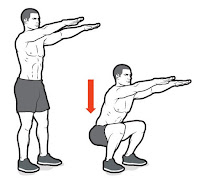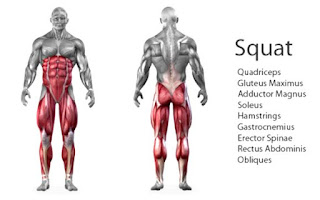Maybe I don't have to talk much here. Everyone should know about the Squats and the two basics steps to do them. Sit down and Stand ups. That is it !
 |
| Bodyweight Squat |
 |
| Squat muscle targeted |
Muscle targeted
Squats will work your entire lower body. They primarily target the muscles in your butt (gluteus maximus), the front of your legs (quadriceps) and the back of your legs (hamstrings). But they also engage some stabilizing muscles: your lower back (erector spinae), the outside of your thighs and bum (abductors), your inner thighs (adductors) and your calves (gastrocnemius and soleus).
Tips for a proper squats
- Different depths of motion in squatting develop different muscles. A full range of motion develops all the muscles equally. For this reason, you should aim to master full squats. Some of the steps are half-movements, but they eXist only as stages in the process towards full squats. Half-movements must always be performed in conjunction with full movements.
- What is a full range of motion for the squat? It means squatting down until your hamstrings are pressing on your calves and you cannot descend any further, before pushing up with thigh and knee power until your legs are fully straight. Anything less is not a full squat.
- • Some people believe that going all the way down is bad for the knees. This is not true. It's only bad for the knees if you have a pre-existing knee problem-and even then, it may help alleviate that problem. Knee tendons can be strained if they are not ready for the low position, but you carefully follow the steps through, your knees will easily be strong enough to take on the full squat.
- Similarly, a lot of bodybuilders dislike the idea of totally straightening the legs at the top of the squat. They think that this allows the thigh muscles to rest, robbing them of work. It's true that straightening the legs fully takes pressure off the muscles momentarily, but provided that brief rest translates into greater levels of strength to pour into the next rep, it can only be a good thing. Straighten your legs fully during squatting.
- Control the negative portion of the movement as much as the positive. Don't just drop down. Lower yourself using muscular control.
- Bend forwards, but don't bend too far forwards when descending. This will overemphasize the hips, and under emphasize the thighs. A frontal tilt is necessary, but don't get into the habit of bowing forwards.
- In the bottom position, you will be virtually "sitting" into the squat. Thinking in terms of sitting rather than squatting can sometimes help athletes descend more naturally, because it facilitates correct hip positioning-which is a fancy way of saying the butt should stick out.
- A pause at the bottom is a good habit, but it's not a panacea. You can still cheat, even with a pause. To get out of the sitting position, some athletes tend to rock forwards. This provides momentum and makes the first few inches easier, but it places undesirable pressure on the knees. Stay sitting, and push up using leg power only. If you can't do this, you are too weak for the exercise you are attempting. Go back to easier steps and keep working at them,
- Some people find that they have to lift their heels off the ground when they squat, so they put a board or block under the heels to help them. This is a bad habit. Needing to elevate the heels has nothing to do with balance or body structure, and everything to do with lack of ankle mobility and inflexibility of the Achilles' tendon. If your ligaments and tendons are stiff, the ankle won't be able to bend sufficiently during the exercise, and your heels will rise. Don't use boards. Stretch your calves out until you can ,squat without assistance.
- I like to keep my arms straight out in front of me during squats. This tends to help balance in the bottom position-it throws some weight forwards, and can offset the tendency to fall back, especially for taller guys. Some bodyweight squatters like to put their hands on their hips, shoulders, or cross their arms on their chest. See what feels easiest for you, depending upon the given exercise.
- Many guys are afraid of the squat, because they think it will aggravate old knee injuries. In fact, the opposite is usually true. The increased blood flow and range of motion in full squats removes waste build-up and stretches old scar tissue, alleviating pain. The knees and surrounding muscles and tendons become stronger and more flexible, and the likelihood of future injuries is lessened.
Squats variations
For variations from the easiest to the hardest, see my article squats progression here.
Comments
Post a Comment